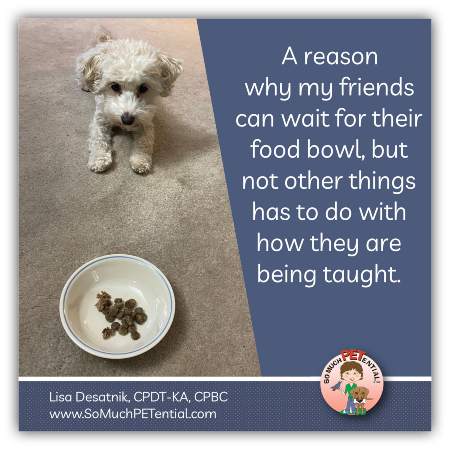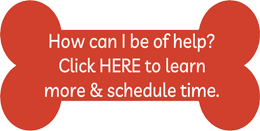Two of the foundation behaviors I like to teach are recall (coming when called) and leave it or wait (meaning leave something alone).
Often a dog will learn to come to the cue of TREAT or will wait for his dinner upon hearing the cue LEAVE IT, but will not reliably do those behaviors at other times. I hear from pet owners about how their dog is really great at sitting while they prepare their dog’s meal and waiting until the food bowl is on the ground to go to it. I also often hear about dogs that will come quickly when called with a cue that is something like, “Treat!” or “Greenie!”.
However, those same people do not have reliability when it comes to asking their dog to come with any other word at any other time; and they do not have reliability when it comes to their dog waiting to greet visitors or to grab something from the ground.
Why Your Dog May Only ‘Leave It’ When It Comes To Dinner
Well, for one, in those specific circumstances, pet owners are very motivated to teach their dog what they want their dog to do. They are focused on getting the outcome they want to see.
 Therefore, they:
Therefore, they:
- Know what criteria they are looking for in the wanted behavior
- Are using a continuous schedule of reinforcement (meaning they are providing reinforcement for every practice of the behavior criteria being met), which is very helpful in teaching behaviors
- Are providing no reinforcement for wrong decisions
- Are using reinforcement that their dog values in that moment
- Have taught the cue that it is a green light predictor that *when* their dog *does* x, *that* a certain outcome will follow
- Have practiced the behavior when their dog is likely to do the behavior
However, at any other time, those same people may have done any number of things to break down the learning of a behavior and its cue.
Just some of those things include:
- Being inconsistent in what criteria they are teaching
- Adding a cue to a behavior before their dog fully understands the criteria for what a behavior should look like
- Being inconsistent in the consequence of the behavior (maybe sometimes their dog gets a treat for coming when called but other times their dog gets taken away from the fun)
- Not using reinforcement that their dog values
- Having poor timing when it comes to marking the behavior (a marker is an indicator to the learner that THAT specific behavior is what has caused the consequence)
- Practicing the behavior when there are too many competing reinforcers without having worked up to that level of training
- Not taking preventative steps in place to keep the unwanted behaviors from occurring
When you are training your dog to do certain behaviors at certain times, it is important to always be thinking in terms of, “How can I help my dog and myself to succeed?”
Here are a few dog training tips to keep in mind to accomplish that:
- Always begin teaching new behaviors in an environment with minimal other competing reinforcers.
- Get to know what your dog values in terms of food, activities, and the environment so that you can use those things in your training.
- When necessary, break the behavior down into steps that make it easier to learn. If, for example, you are teaching your dog to go to a mat, you may want to teach your dog to first orient to it, then move toward it, then put a paw on it, then put four paws on it, etc. This is called shaping and it is a fun way of teaching behaviors using clicker training.
- Teach the behavior with a high rate of reinforcement first before adding the cue.
- Keep training sessions short and then incorporate teaching into every day moments.
- Have preventative measures in place to keep your dog from practicing unwanted choices, as those choices will be reinforced.
- Be adaptable. You may need to change how or when you are training depending on the feedback from your dog. If your dog is not learning what you are trying to teach, stop and rethink what you can change to have more success.







